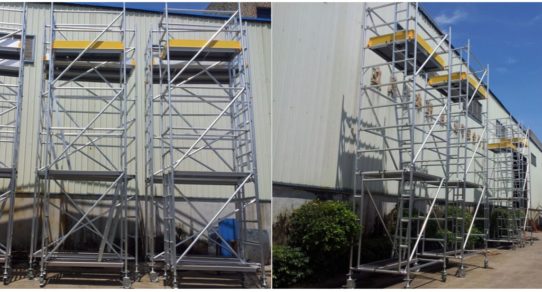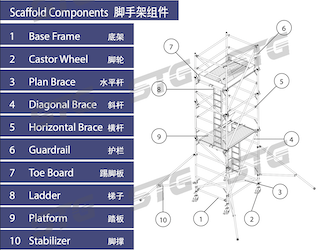Wooden or timber scaffolding is an essential tool for many construction and renovation projects, but it can also be dangerous if not properly installed and maintained. In this blog post, we will discuss how to properly set up, secure, and inspect wooden scaffolding to ensure optimal safety and efficiency. Proper installation and maintenance of wooden scaffolding is crucial to ensuring optimal safety and efficiency when working on construction projects. Wooden scaffolding is a popular choice for many builders and contractors due to its durability, cost-effectiveness, and ease of use. However, it is important to follow proper installation and maintenance procedures to ensure the safety of all workers and the stability of the scaffold.
Proper Set Up
Proper set up of wooden scaffolding is essential to ensuring the safety and stability of the scaffold, as well as the safety of workers using it. The first step in setting up wooden scaffolding is to make sure that the area is clear of debris and any potential hazards. This includes removing any loose rocks or debris that may be present, as well as ensuring that there are no overhead power lines or other hazards that could pose a risk to workers. Make sure that the base of the scaffolding is level and secure, and that all of the components are properly aligned and tightened. It is also important to ensure that the scaffolding is on a solid surface, such as concrete or asphalt, and that it is not set up on soft or uneven ground.
It’s also important to note that the assembly should always be done by a professional that is experienced and certified in the proper use and assembly of wooden scaffolding. Do not use wooden rollers that are split or rotten. The wooden rollers should be of a certain size and thickness that complies with the Singapore Standards.
Securing the Scaffold
Next, it is important to properly secure the wooden scaffolding. This includes ensuring that all of the components are properly tied and secured using PVC lashings, and that all of the connections are tight. It is also important to make sure that the scaffolding is properly tied off to a solid structure, such as a building or a wall, to prevent it from tipping over.
Securing the scaffold is an important step in ensuring its stability and the safety of workers. This includes making sure that all the connections are tight and that the scaffold is properly braced.
Inspection
Regular inspections are a crucial aspect of ensuring that the scaffold is in good condition and safe for use. By inspecting the scaffold before each use, you can catch any potential issues before they become a safety hazard. It also ensures that no parts are missing or damaged, which can compromise the structural integrity of the scaffold.
When conducting inspections, it is important to look for any signs of wear or tear on the scaffold. This includes checking for cracks or splits in the wood, which can weaken the scaffold and make it less stable. Never carry out hot works while using a wooden scaffold. Do not overload the wooden scaffold. The safe working load is only 75 kgf/sqm equivalent to a maximum of two men per bay. The maximum height for a wooden scaffold is fifteen metres. Also, check for adequate tie-backs secured at every four metre height. Inspect the guardrails, bracing, ladder access, working platforms, toe-boards and make sure that they are properly installed and in good condition.
If any damage or missing parts are found during an inspection, it is important to replace or repair them immediately. This will help to ensure the structural integrity of the scaffold and the safety of workers.
Safety Protocols
Following proper safety protocols is crucial when using wooden scaffolding. This includes using proper fall protection equipment, such as full body harnesses and safety tie-offs, and making sure that all workers are properly trained on how to use the scaffold. It’s also important to make sure that the scaffold is not overloaded, and that workers are not exceeding the weight limit of the scaffold.
Maintenance
Wooden scaffolding requires regular maintenance to keep it in good condition. This includes regularly checking for rotting or damaged wood, tightening any loose connections, and replacing any worn or damaged parts. The duration of use cannot exceed 9 months.
Let Us Help You Decrease Workplace Injuries and Increase Productivity
Proper installation, maintenance, and adherence to safety protocols are essential for ensuring optimal safety and efficiency when working with wooden scaffolding. Regular inspections and maintenance will help to ensure that the scaffold is in good condition and that any potential hazards are identified and addressed in a timely manner. Remember to use proper fall protection equipment, and to make sure that workers are properly trained and qualified to use the scaffold. And always be aware of the weight limit of the scaffold and never overload the scaffold.
Kim Sing Scaffolding manages the risk of your workplace by conducting risk assessments, developing fall prevention policies and ensuring all workers are trained in safe work practices. We conduct scaffold inspections and modification, provide scaffolding equipment service and installation, dismantle and remove scaffold components when they are no longer needed.
In conclusion, wooden scaffolding is an essential tool for many construction and renovation projects, but it can also be dangerous if not properly installed and maintained. By properly setting up, securing, and inspecting the scaffolding, as well as following proper safety protocols, you can ensure optimal safety and efficiency when using wooden scaffolding. Remember, safety should always be the number one priority when working on any construction or renovation project.






